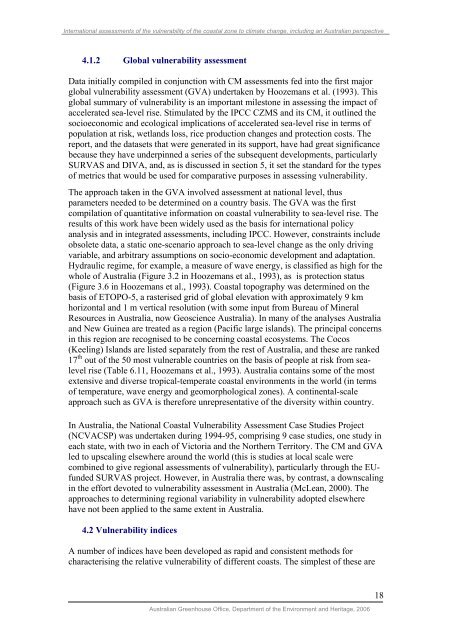International assessments of the vulnerability.pdf - Climate ...
International assessments of the vulnerability.pdf - Climate ...
International assessments of the vulnerability.pdf - Climate ...
You also want an ePaper? Increase the reach of your titles
YUMPU automatically turns print PDFs into web optimized ePapers that Google loves.
<strong>International</strong> <strong>assessments</strong> <strong>of</strong> <strong>the</strong> <strong>vulnerability</strong> <strong>of</strong> <strong>the</strong> coastal zone to climate change, including an Australian perspective<br />
4.1.2 Global <strong>vulnerability</strong> assessment<br />
Data initially compiled in conjunction with CM <strong>assessments</strong> fed into <strong>the</strong> first major<br />
global <strong>vulnerability</strong> assessment (GVA) undertaken by Hoozemans et al. (1993). This<br />
global summary <strong>of</strong> <strong>vulnerability</strong> is an important milestone in assessing <strong>the</strong> impact <strong>of</strong><br />
accelerated sea-level rise. Stimulated by <strong>the</strong> IPCC CZMS and its CM, it outlined <strong>the</strong><br />
socioeconomic and ecological implications <strong>of</strong> accelerated sea-level rise in terms <strong>of</strong><br />
population at risk, wetlands loss, rice production changes and protection costs. The<br />
report, and <strong>the</strong> datasets that were generated in its support, have had great significance<br />
because <strong>the</strong>y have underpinned a series <strong>of</strong> <strong>the</strong> subsequent developments, particularly<br />
SURVAS and DIVA, and, as is discussed in section 5, it set <strong>the</strong> standard for <strong>the</strong> types<br />
<strong>of</strong> metrics that would be used for comparative purposes in assessing <strong>vulnerability</strong>.<br />
The approach taken in <strong>the</strong> GVA involved assessment at national level, thus<br />
parameters needed to be determined on a country basis. The GVA was <strong>the</strong> first<br />
compilation <strong>of</strong> quantitative information on coastal <strong>vulnerability</strong> to sea-level rise. The<br />
results <strong>of</strong> this work have been widely used as <strong>the</strong> basis for international policy<br />
analysis and in integrated <strong>assessments</strong>, including IPCC. However, constraints include<br />
obsolete data, a static one-scenario approach to sea-level change as <strong>the</strong> only driving<br />
variable, and arbitrary assumptions on socio-economic development and adaptation.<br />
Hydraulic regime, for example, a measure <strong>of</strong> wave energy, is classified as high for <strong>the</strong><br />
whole <strong>of</strong> Australia (Figure 3.2 in Hoozemans et al., 1993), as is protection status<br />
(Figure 3.6 in Hoozemans et al., 1993). Coastal topography was determined on <strong>the</strong><br />
basis <strong>of</strong> ETOPO-5, a rasterised grid <strong>of</strong> global elevation with approximately 9 km<br />
horizontal and 1 m vertical resolution (with some input from Bureau <strong>of</strong> Mineral<br />
Resources in Australia, now Geoscience Australia). In many <strong>of</strong> <strong>the</strong> analyses Australia<br />
and New Guinea are treated as a region (Pacific large islands). The principal concerns<br />
in this region are recognised to be concerning coastal ecosystems. The Cocos<br />
(Keeling) Islands are listed separately from <strong>the</strong> rest <strong>of</strong> Australia, and <strong>the</strong>se are ranked<br />
17 th out <strong>of</strong> <strong>the</strong> 50 most vulnerable countries on <strong>the</strong> basis <strong>of</strong> people at risk from sealevel<br />
rise (Table 6.11, Hoozemans et al., 1993). Australia contains some <strong>of</strong> <strong>the</strong> most<br />
extensive and diverse tropical-temperate coastal environments in <strong>the</strong> world (in terms<br />
<strong>of</strong> temperature, wave energy and geomorphological zones). A continental-scale<br />
approach such as GVA is <strong>the</strong>refore unrepresentative <strong>of</strong> <strong>the</strong> diversity within country.<br />
In Australia, <strong>the</strong> National Coastal Vulnerability Assessment Case Studies Project<br />
(NCVACSP) was undertaken during 1994-95, comprising 9 case studies, one study in<br />
each state, with two in each <strong>of</strong> Victoria and <strong>the</strong> Nor<strong>the</strong>rn Territory. The CM and GVA<br />
led to upscaling elsewhere around <strong>the</strong> world (this is studies at local scale were<br />
combined to give regional <strong>assessments</strong> <strong>of</strong> <strong>vulnerability</strong>), particularly through <strong>the</strong> EUfunded<br />
SURVAS project. However, in Australia <strong>the</strong>re was, by contrast, a downscaling<br />
in <strong>the</strong> effort devoted to <strong>vulnerability</strong> assessment in Australia (McLean, 2000). The<br />
approaches to determining regional variability in <strong>vulnerability</strong> adopted elsewhere<br />
have not been applied to <strong>the</strong> same extent in Australia.<br />
4.2 Vulnerability indices<br />
A number <strong>of</strong> indices have been developed as rapid and consistent methods for<br />
characterising <strong>the</strong> relative <strong>vulnerability</strong> <strong>of</strong> different coasts. The simplest <strong>of</strong> <strong>the</strong>se are<br />
Australian Greenhouse Office, Department <strong>of</strong> <strong>the</strong> Environment and Heritage, 2006<br />
18

















